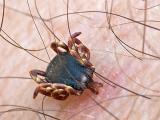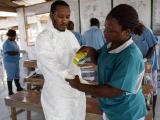Aug 3, 2009 (CIDRAP News) – Scientists from the US Centers for Disease Control and Prevention (CDC) and Africa have for the first time isolated Marburg viruses from fruit bats found in a Ugandan cave where humans were infected, a finding that suggests bats may be a natural host of the virus.
The group reported their findings in the Jul 13 issue of Public Library of Science Pathogens (PLoS Pathogens). The natural reservoirs for the Marburg virus and its close relative, Ebola virus, have long been the subject of speculation.
The CDC said in a Jul 31 press release that caves where the bats dwell in Africa are popular tourist attractions, and some bat-infested mines are actively used by local people, putting bats and people in close contact.
A Dutch woman died of Marburg hemorrhagic fever in 2008 after visiting a "python cave" in western Uganda, and the illness was confirmed in a US patient who had visited the same cave a few months earlier. The current study was prompted by a death and confirmed and suspected Marburg illnesses in lead and gold miners who worked at Kitaka Cave in remote western Uganda.
"By identifying the natural source of this virus, appropriate public health resources can be directed to prevent future outbreaks," the CDC said in the statement. Understanding more about transmission between bats and humans may provide clues to prevention or treatment for Marburg virus infections. Currently, no vaccine or specific treatment is available.
Previous studies had found antibodies to and genetic fragments of the Marburg virus in the bats, but no live virus.
In the current study, researchers trapped and took blood and tissue samples from bats at Kitaka Cave during two visits, one in August 2007 after the miners were sickened and one in May 2008.
Bats at the cave appeared healthy enough to seek food. The team found active Marburg virus infections in 5% (31 of 611) of Egyptian fruit bats, common in Africa, the eastern Mediterranean, and the Middle East, and isolated the live virus from five animals. Four of the isolates came from animals trapped during the 2007 trip, and one came from an animal sampled in 2008.
The research group reported that sampling large numbers of bats and flash freezing and preserving samples in liquid nitrogen immediately after dissection helped them successfully isolate the live virus. Also, they said launching the ecological study soon after the outbreak in humans enabled them to do their work while the virus activity in the bats was probably still high.
The scientists didn't find any viral DNA in oral swabs taken from the bats, but they said ruling out saliva transmission would be premature given the limited number of bats tested. They found no evidence of vertical transmission when they tested the placentas of pregnant female bats.
They projected that more than 5,000 infected bats could have been in the colony at any one time, "suggesting that there is a high risk of infection for humans who spend extended periods in close proximity to the bats," they wrote.
Genetic analysis of the Marburg sequences from the bats and the miners found that diverse Marburg lineages were circulating in the cave's bats, suggesting that the virus had circulated in the bats for a long time, and that some of the sequences were nearly identical to the human isolates.
Towner JS, Amman BR, Sealy TK, et al. Isolation of genetically diverse Marburg viruses from Egyptian fruit bats. PLoS Pathogens 2009 Jul 21;5(7):[Full text]
See also:
Jul 31 CDC press release
Aug 22, 2007, CIDRAP News story "Traces of Marburg virus found in African bats"
















